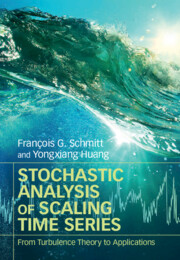Book contents
- Frontmatter
- Contents
- List of figures
- Preface
- 1 Introduction: a multiscale and turbulent-like world
- 2 Homogeneous turbulence and intermittency
- 3 Scaling and intermittent stochastic processes
- 4 New methodologies to deal with nonlinear and scaling time series
- 5 Applications: case studies in turbulence
- 6 Applications: case studies in ocean and atmospheric sciences
- References
- Index
4 - New methodologies to deal with nonlinear and scaling time series
Published online by Cambridge University Press: 05 December 2015
- Frontmatter
- Contents
- List of figures
- Preface
- 1 Introduction: a multiscale and turbulent-like world
- 2 Homogeneous turbulence and intermittency
- 3 Scaling and intermittent stochastic processes
- 4 New methodologies to deal with nonlinear and scaling time series
- 5 Applications: case studies in turbulence
- 6 Applications: case studies in ocean and atmospheric sciences
- References
- Index
Summary
As mentioned previously, turbulent flows or turbulent-like phenomena possess in many aspects self-similarity or multiscaling properties and multiscale statistics. The classical way to characterize this scaling behavior is to estimate the qth-order structure function Sq(l) for different scales. Power-law behavior is then expected, e.g., Sq(l) ~ lζ(q), in which Sq(l) represents the qth-order structure function (see Chapter 2). The structure function method was first proposed by Kolmogorov in 1941 in his famous homogeneous and isotropic turbulence paper. There are also to be found other methodologies to characterize the multiscale statistics of such fields. Such examples include: wavelet-based approaches; the Hilbert-Huang transform; detrended fluctuation analysis; and detrended structure function analysis, to mention a few. Each method has its own advantages and disadvantages as it might show different performances for different types of data. Before applying one of these methods to real data, it is necessary to know whether the method is suitable for that data. For example, in the fluid geosciences, the annual cycle is present in many observation data, and therefore the structure function analysis, as we show below, might not be suitable. Here, other methodologies which might constrain the large-scale influence should be considered.
In this chapter, we will present more details about the classical structure-function analysis and new approaches that have emerged in recent years. This chapter is organized as follows. The increment-based methods are introduced in Sections 4.1 to 4.3. The wavelet-based methods are presented in Section 4.7. The Hilbert-based method is described in Section 4.8.
Structure function analysis
Second-order structure function
We first consider here the second-order structure functions (SFs). The second-order SF is defined as,
in which l is a separation scale (Figure 4.1). Originally, such an approach was done for spatial scales; however, as explained in Chapter 2, we are dealing here with time series and transform spatial fluctuation into time fluctuation using Taylor's frozen hypothesis, hence, here l is a time scale.
Information
- Type
- Chapter
- Information
- Stochastic Analysis of Scaling Time SeriesFrom Turbulence Theory to Applications, pp. 56 - 100Publisher: Cambridge University PressPrint publication year: 2016
